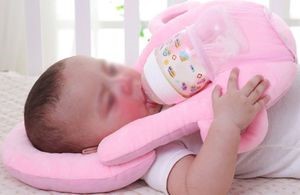Baby self-feeding pillows
What are baby self-feeding pillows?
A self-feeding pillow is designed to hold a bottle, keep it in the baby’s mouth and free up the parent’s hands, allowing the baby to feed itself.

What are the safety risks?
Self-feeding pillows are dangerous products designed to allow a baby to feed on a bottle without the assistance of a caregiver. They go against HSE safe bottle-feeding advice. When used as intended, they create a risk of serious harm or death from:
- choking
- aspiration pneumonia
What should I do?
Consumers should not buy self-feeding pillows, if you have one in your home you should immediately stop using it and dispose of it safely so that it cannot be used by anyone else.
Businesses must immediately remove these products from the market as they are not safe products under the European Communities (General Product Safety) Regulations 2004 [S.I. No. 199/2004].
Additional information
Self-feeding pillows are regulated under S.I. No. 199/2004 – European Communities (General Product Safety) Regulations 2004, which requires them to be safe products. The HSE advice on safe bottle-feeding states that a caregiver should:
- always hold the baby in their arms when bottle feeding
- always hold the bottle in their hand
- never lean or prop the bottle against a self-feeding pillow or any other support
- never leave the baby to drink a bottle on their own
A self-feeding pillow is designed to hold a bottle, keep it in the baby’s mouth and free up the parent’s hands, allowing the baby to feed itself. The pillow is placed around the baby’s neck, the bottle is held in position by a piece of elastic or a pouch and the baby is positioned on its back to feed itself without the assistance of a caregiver holding the bottle and controlling the feed.
In this situation the baby will not be able to control the flow of milk and the milk will continue to flow even if the baby is not swallowing. This can lead to choking. Choking can be silent and a baby will not have the dexterity or cognitive behaviour to otherwise raise the alarm.
Aspiration pneumonia occurs when milk goes into the lungs rather than the stomach. This could occur if the flow of milk is too fast and the baby is not able to keep up by swallowing the milk.


